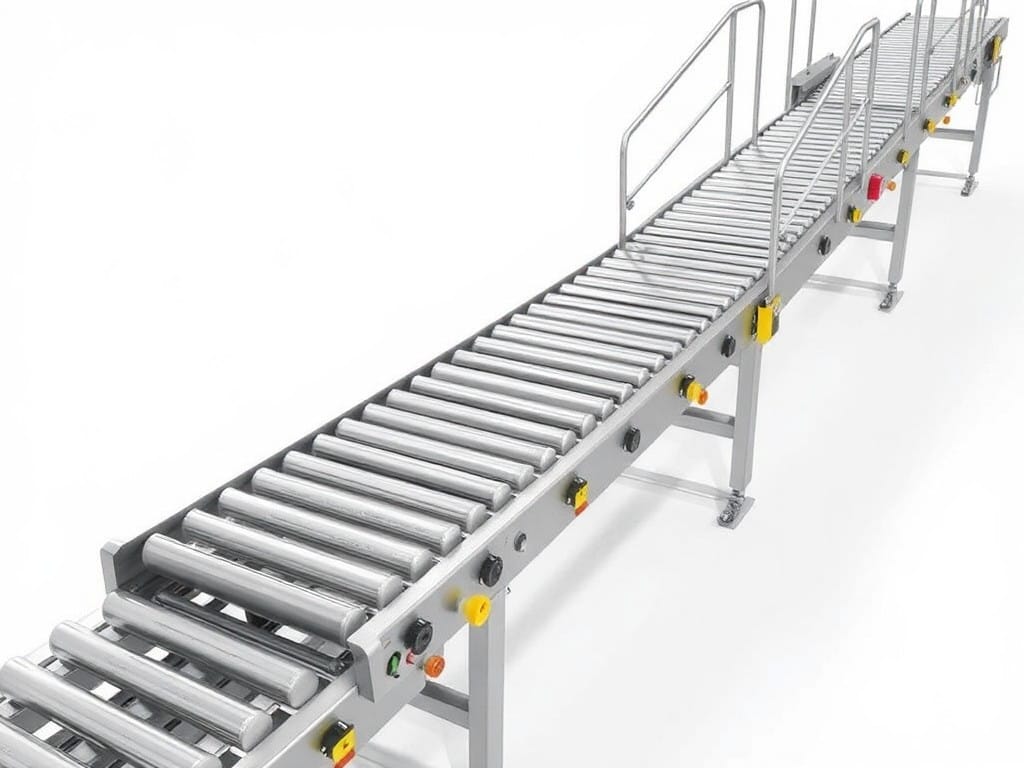Roller conveyor systems are essential components in modern material handling and logistics. These systems consist of a series of cylindrical rollers arranged in a frame, allowing for the efficient movement of goods and materials across various industries. Designed to facilitate the transport of items with minimal effort, roller conveyors significantly enhance productivity by reducing manual handling and streamlining workflows.
As technology continues to evolve, roller conveyor systems are also advancing, incorporating features such as automation and smart monitoring. This integration allows businesses to optimize their operations further, ensuring efficient and reliable material flow. In this essay, we will explore the functionality, benefits, applications, and future trends of roller conveyor systems, highlighting their importance in today’s fast-paced industrial landscape.
Description
Toshine Chain Driven Live Roller Conveyor Manufacturer

Ensure smooth conveying, even for heavy loads, with our Toshine Pallet Roller Conveyor. The roller chain effectively transfers power from the motor to each roller, delivering consistent movement. You can use this conveyor for applications where the pallet runners run parallel to the direction of travel. Plus, it performs well in tough environments that have excessive dust, moisture, water, or oil.
When it comes to choosing the Toshine Pallet Conveyor, you have several options. You can pick from conveyor sections only, complete conveyor systems with controls, or fully pre-wired systems that are ready to go.
- Technology: Enjoy maximum throughput while keeping maintenance to a minimum.
- Product Size: This conveyor can handle a variety of pallet sizes, shapes, and materials.
- Capacity: It is designed to manage loads of up to 1000 kg or 1500 kg.
- Accessible: You can easily access both sides of the conveyor for loading and unloading pallets.
- Easy Installation: Installing the conveyor is a breeze. We assemble and test each section before shipping, so you can get started right away.
What are the differences between roller conveyors and belt conveyors?
The main differences between roller conveyors and belt conveyors are important to understand:
- Speed: First, belt conveyors are better for high-speed operations. In contrast, roller conveyors excel at slower speeds.
- Control: Next, belt conveyors provide more control. They offer better support for products, especially on slopes. On the other hand, roller conveyors do not control loads as accurately as belt conveyors do.
- Maintenance: Additionally, belt conveyors usually require less maintenance compared to roller conveyors. This can help save time and resources.
- Applications: Moreover, belt conveyors are more versatile. They are used in many industries, such as food processing, manufacturing, and automotive. Meanwhile, roller conveyors are often found in warehouses and manufacturing facilities.
- Configurations: When it comes to configurations, roller conveyors are typically limited to horizontal setups. However, belt conveyors can transport products between different heights within a facility.
- Material Adherence: Lastly, roller conveyors have low material adherence, which helps reduce spillage and prevents problems with tracking.
In many situations, conveyor systems combine both belts and rollers. This mix creates the most efficient flow for moving products.
How does A Roller Conveyor Work?

A roller conveyor consists of a series of cylindrical rollers mounted on frames. These rollers allow products or materials to move along the conveyor with minimal friction. Here’s how it works:
- Gravity or Power-Driven: Roller conveyors can be gravity-driven or powered. In gravity systems, products move down the conveyor slope. In powered systems, an electric motor drives the rollers to move the items.
- Load Placement: When placing items on the conveyor, they rest on the rollers. The design allows the load to roll easily over the surface.
- Movement: For powered roller conveyors, when the motor activates, it turns the rollers. This rotation pushes the items along the conveyor. In gravity systems, items move forward due to the slope of the conveyor.
- Direction Control: Roller conveyors can be configured to transport items in a straight line or around curves. This flexibility helps direct the flow of materials within a facility.
- Loading and Unloading: Workers can easily load items onto the conveyor from either side. Similarly, they can unload items at the end or from the sides as needed.
Overall, roller conveyors are efficient systems for transporting goods in warehouses, assembly lines, and manufacturing settings. They simplify the movement of items and reduce manual handling, improving productivity.
Conclusion
In summary, roller conveyors are a vital component of material handling systems. Their efficiency, versatility, and low maintenance make them an excellent choice for various applications. By understanding their operation and benefits, businesses can leverage roller conveyors to enhance productivity and streamline operations.
As technology continues to advance, the future of roller conveyors promises even greater efficiency and capability, making them an essential asset in the logistics and manufacturing sectors.
Feel free to expand on any of these sections or adjust them to fit your specific requirements!





